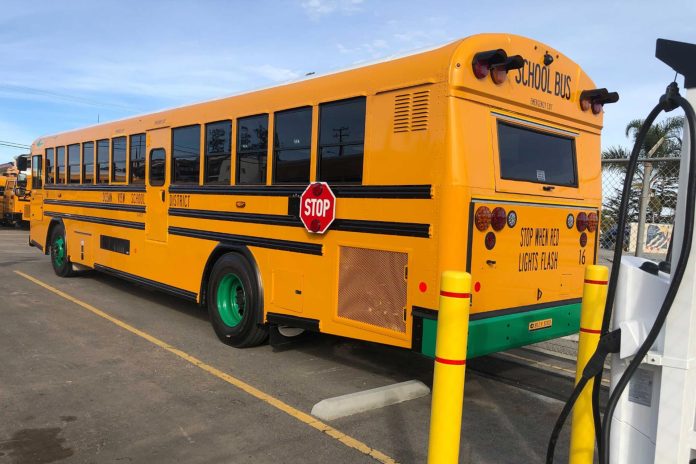Gov. Gavin Newsom ended the suspense by putting his signature to Assembly Bill 579, which will require upwards of $5 billion to complete the state’s transition to zero-emissions school buses.
Newsom signed the legislation on Sunday, six days ahead of the deadline to approve or veto all bills passed during the recent legislative session. California now joins Connecticut, Maine, Maryland and New York in mandating new purchases or fully zero-emissions fleets — currently meaning those powered by electric batteries — over the coming four to 17 years.
A fiscal summary from the California Department of Finance opposed the bill. It notes that school districts will need $5 billion in state Proposition 98 general funds over the next decade to only purchase zero-emissions school buses and chargers, starting on Jan. 1, 2035.
“This estimate assumes the average cost differential between an electric school bus and a diesel bus is $200,000, resulting in costs of approximately $4 billion to acquire 20,200 electric school buses, and assumes average electric charging infrastructure costs of roughly $50,000 per bus, or just over $1 billion,” the Department of Finance wrote in June.
There are about 23,800 school buses (public and private) in the statewide fleet. About 500 electric school buses are on the road, and another 2,078 are committed — they are already ordered or on the way to school districts — according to the World Resources Institute Electric School Bus Initiative. The state legislature last year approved an additional $1.5 billion over three years, which will pay for approximately 3,100 electric school buses.
Related: The State of Electric School Bus Adoption in the U.S.
Clean energy trade group Advanced Energy United cited its own total cost of ownership analysis indicating that by 2032 electric school buses will save money over their lifecycle, compared to diesel school buses. In a statement on Sunday, the organization noted that federal funds from U.S. Environmental Protection Agency’s Clean School Bus Program will also aid in the transition.
Ryan Gallentine, the Advanced Energy United’s transportation policy director, also commented last week that the bill extends lease terms for electric school buses.
Meanwhile, all school districts — including “frontier districts” defined by state law as having an average daily attendance of fewer than 600 students or located in a county with a total population density of fewer than 10 persons per square mile — are eligible for a five-year extension starting in 2040, if they can “reasonably demonstrate that a daily planned bus route for transporting pupils to and from school cannot be serviced through available zero-emission technology in 2035.”
The California Air Resources Board (CARB) will approve the request in consultation with the California Department of Education and the State Energy Resources Conservation and Development Commission.
Educational organizations opposed the bill, citing vehicle range concerns for starters. In a statement, the California Association of School Business Officials noted that most school districts require school buses to travel long distances to various student events. It also said that school districts currently wait four to six months for service from school bus manufacturers and dealers — the only entities currently able to provide maintenance — when an electric bus breaks down.
Related: California Legislature Passes 2035 Electric School Bus Mandate
Related: More Funding for California Electric School Buses, Infrastructure Now Available
Related: California District ‘Blueprint’ Highlights Benefits of Charge Management Solutions, AC Chargers
Related: Watch: Taking a Healthy Ride on the Green Side
Related: (STN Podcast E180) Moving Toward EVs: Clean School Bus Program, Green NY Contractor Conversation
Last week, the California Association of School Transportation Officials pointed out “challenges related to costs, infrastructure, and feasibility in certain areas in California.”
“A zero-emission school bus has a limited range and could encroach on the distances school districts and private carriers have to transport student,” said Michael Sawyer, president of CASTO and director of transportation for San Marcos Unified School District near San Diego. “The round-trip mileage from my city to Disneyland is 150 miles. The current range on the zero-electric buses ranges from 100 miles to 140 miles on a fully charged battery. I could not use the electric buses on these trips.”
He also observed there are currently no internal combustion engine alternatives available to school districts that meet CARB requirements for sales of new Class 6 or Class 7 school buses.
Still, WRI celebrated a “full circle moment for California.”
“Nearly 10 years ago, three school districts in California deployed the country’s first electric school buses, and within a decade, state leaders have now taken this critical step to ensure all students across the state will benefit from a clean commute to school,” concluded said Sue Gander, director of WRI’s Electric School Bus Initiative. “California is far and away the leader in state funding for electric school buses.”














